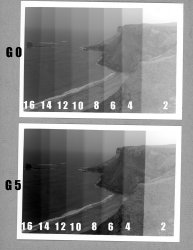- Joined
- Aug 6, 2016
- Messages
- 1,586
I have been reading about split grade printing and how sometimes it can be beneficial. http://www.lesmcleanphotography.com/articles.php?page=full&article=21
Here are 2 test strips I have made. One on Grade 0 and the other on Grade 5, each one had a 2 second exposure. I would like advice on how best to interpret these. I think 6 seconds on the G5 looks about right for the low values.
The high values I am not sure how to deal with especially the sky. The 2 second exposure on G0 is showing pale tones which I could live with but not quite sure how to proceed.

Here are 2 test strips I have made. One on Grade 0 and the other on Grade 5, each one had a 2 second exposure. I would like advice on how best to interpret these. I think 6 seconds on the G5 looks about right for the low values.
The high values I am not sure how to deal with especially the sky. The 2 second exposure on G0 is showing pale tones which I could live with but not quite sure how to proceed.


